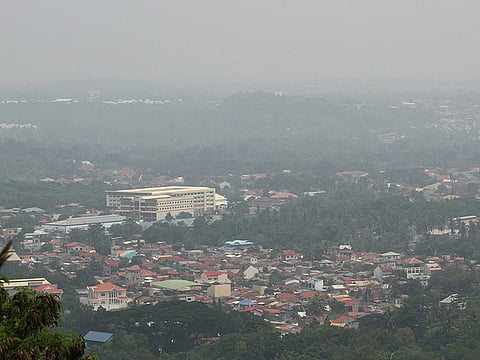Parts of Philippines to suffer Indonesia’s haze until 2016 due to El Nino
Parts of Mindanao and Visayas suffered haze after Indonesia’s forest fires reached a crisis level

Manila: The severe dry season caused by the El Nino phenomena will make central and southern Philippines suffer Indonesia’s haze until early 2016, despite a combined regional effort in Southeast Asia to tackle forest fires in Indonesia’s eastern part, sources said.
“The problem of forest fires from Indonesia will affect parts of the Visayas and Mindanao because of El Nino — it brought drought to parts of the Philippines and Indonesia,” Joe Frivaldo, weather specialist of state-run Pagasa told Gulf News.
El Nino effects will remain in the Philippines even after the start of cold weather in October, November and December,” said Fivaldo, adding that El Nino effects will intensify in Indonesia until December.
For a week, parts of Mindanao and the Visayas suffered haze after Indonesia’s forest fires reached a crisis level, with 357 hot spots on Kalimantan Island and 825 on Sumatra, Mario Goya, weather specialist of Pagasa’s regional office said.
“Indonesia’s haze entered the Philippines because of three seemingly disparate events,” said Goya, adding, “It began because of the country’s southwest monsoon rains; when Typhoon Koppu landed on the eastern seaboard of northern Luzon (which is 1,000 kilometres away from southern Philippines) on October 18; the presence of another tropical storm at the heels of Koppu in the Pacific Ocean last week. They all pulled Indonesia’s haze northwest up to the central and southern Philippines.”
Gina Sabit, a resident of Cagayan de Oro told Channel 2, “Because of the haze from Indonesia, we could not see houses that used to be visible from our home (in Cagayan de Oro).”
“Slight drizzle and heavy rains failed to lift up the haze from our place,” she added.
As a result, operations in one airport in Cebu, central Philippines, and five in Mindanao, southern Philippines, were suspended due to low visibility that was blamed on Indonesia’s haze, said the Civil Aviation Authority of the Philippines (CAAP).
Affected airports included one in Mactan, Cebu, central Philippines and five more in southern Philippines’ Cotabato, Davao, General Santos, Misamis Oriental, and Zamboanga City, CAAP said, but it deferred issuing a general prohibition of flight in these affected airports.
The Manila International Airport Authority was worried that cancelled and delayed flights from the six affected airports could affect flight traffic at the three terminals of Pasay City’s Ninoy Aquino International Airports.
Dr David Mendoza, regional epidemiologist, warned: “Indonesia’s haze is made of smoke, particles, and pollutants like carbon monoxide, nitrogen dioxide, and sulphurdioxide. They can irritate the eyes, skin, sinuses, and throat of children, elderly, and those with diabetes, heart and lung conditions.”
“Drink plenty of water, eat healthy food, exercise indoors, stay at home, and wear face mask when going outside,” said Mendoza, adding the health department began an information health campaign in the south.
Indonesia’s haze problem has perennially affected Malaysia and Singapore, more recently, Papua, the Philippines and Thailand, or a total of 30 million suffering from the environmental malady this year, said scientist Herry Purnomo of Indonesia’s Centre for International Forestry Research.
Region-wide haze crisis from Indonesia erupted in 1997, 1998, and 2006.
Sign up for the Daily Briefing
Get the latest news and updates straight to your inbox



